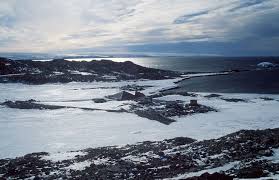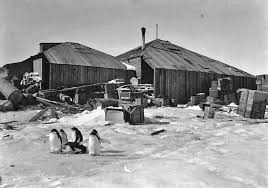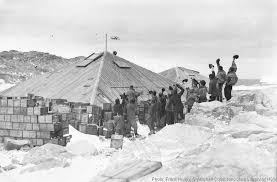History of Antarctica
The continent of Antarctica has always been associated with exploration, first trying to find it, then trying to explore it and its features. Most of the early diaries and tales of Antarctic exploration are filled with stories of how the weather was man’s biggest enemy on the continent. Many people have pitted their strength and wit against the snow and ice of the southern continent. Four names stand out in the history of Antarctic exploration: Ernest Shackleton, Roald Amundsen, Robert Falcon Scott, and Sir Douglas Mawson. It was to Mawson’s site that Marion would travel.
 The Australasian Antarctic Expedition (1911–14), which aimed to undertake science and exploration, saw Douglas Mawson establish his base at Commonwealth Bay. His unique site is still essentially the same as it was when Mawson left in 1914.
The Australasian Antarctic Expedition (1911–14), which aimed to undertake science and exploration, saw Douglas Mawson establish his base at Commonwealth Bay. His unique site is still essentially the same as it was when Mawson left in 1914.
The SY Aurora, under the command of John King Davis, and laden with all the supplies and animals needed for the science and exploration teams on both Macquarie Island and Cape Denison, sailed away down the Derwent River from Hobart, Tasmania, on December 2nd 1911.
Bound first for Macquarie Island, the strong and sturdy wooden ship ploughed its way through the gales and rough seas of the ferocious Southern Ocean. It took nine days to reach Macquarie Island, where the construction of the base and radio communication antenna became a dress rehearsal for erecting the same at Cape Denison. Turning to the South and to Antarctica, the Aurora continued in now calmer seas, reaching extensive pack ice and huge icebergs. Mawson was concerned that this pack ice and the steep ice cliffs would prevent the landing of the expedition, until he spotted the rocky cape and glided into Commonwealth Bay, where abundant wildlife (penguins and seals) and the rocky islands drew Mawson to launch a whaleboat to investigate the area.
 Liking what he saw, they began unloading the 23 tonnes of coal and other fuels, 2 years of food supplies, tools, wireless masts and scientific equipment, the air tractor and personal effects. For the pre-fabricated huts to be assembled, the bedrock had to be blasted using dynamite (which had to be warmed up in a jacket pocket!).50 tonnes of rock was then placed around the foundations for extra security.
Liking what he saw, they began unloading the 23 tonnes of coal and other fuels, 2 years of food supplies, tools, wireless masts and scientific equipment, the air tractor and personal effects. For the pre-fabricated huts to be assembled, the bedrock had to be blasted using dynamite (which had to be warmed up in a jacket pocket!).50 tonnes of rock was then placed around the foundations for extra security.
It was decided to join together the smaller work room and the larger living area, to make a more workable and more secure space. The stove would be in the living room, with its dual purpose of cooking and heating. The skylights and the acetylene plant would give the light. The Workshop held the radio equipment, motor generator and a lathe, and benches for other flat work.
 The night they all moved in was the first night of a blizzard that lasted for the whole month of February! That did not stop the other tasks of erecting the radio masts, the Magnetograph hut and the Absolute Magnetic hut, a tide gauge, and an anemometer for measuring wind speed. There were “Household chores” as well. Snowed in sometimes to the roof line, a permanent ice tunnel was dug, allowing access to the outside, and practice for preparing the ice caves to store supplies, and people, to wait out the fierce storms of winter.
The night they all moved in was the first night of a blizzard that lasted for the whole month of February! That did not stop the other tasks of erecting the radio masts, the Magnetograph hut and the Absolute Magnetic hut, a tide gauge, and an anemometer for measuring wind speed. There were “Household chores” as well. Snowed in sometimes to the roof line, a permanent ice tunnel was dug, allowing access to the outside, and practice for preparing the ice caves to store supplies, and people, to wait out the fierce storms of winter.
As the Sun peeked over the horizon, winter began to recede. Come the penguins (in October), come the Summer! The 18 expeditioners were ready to tackle the next tasks.
